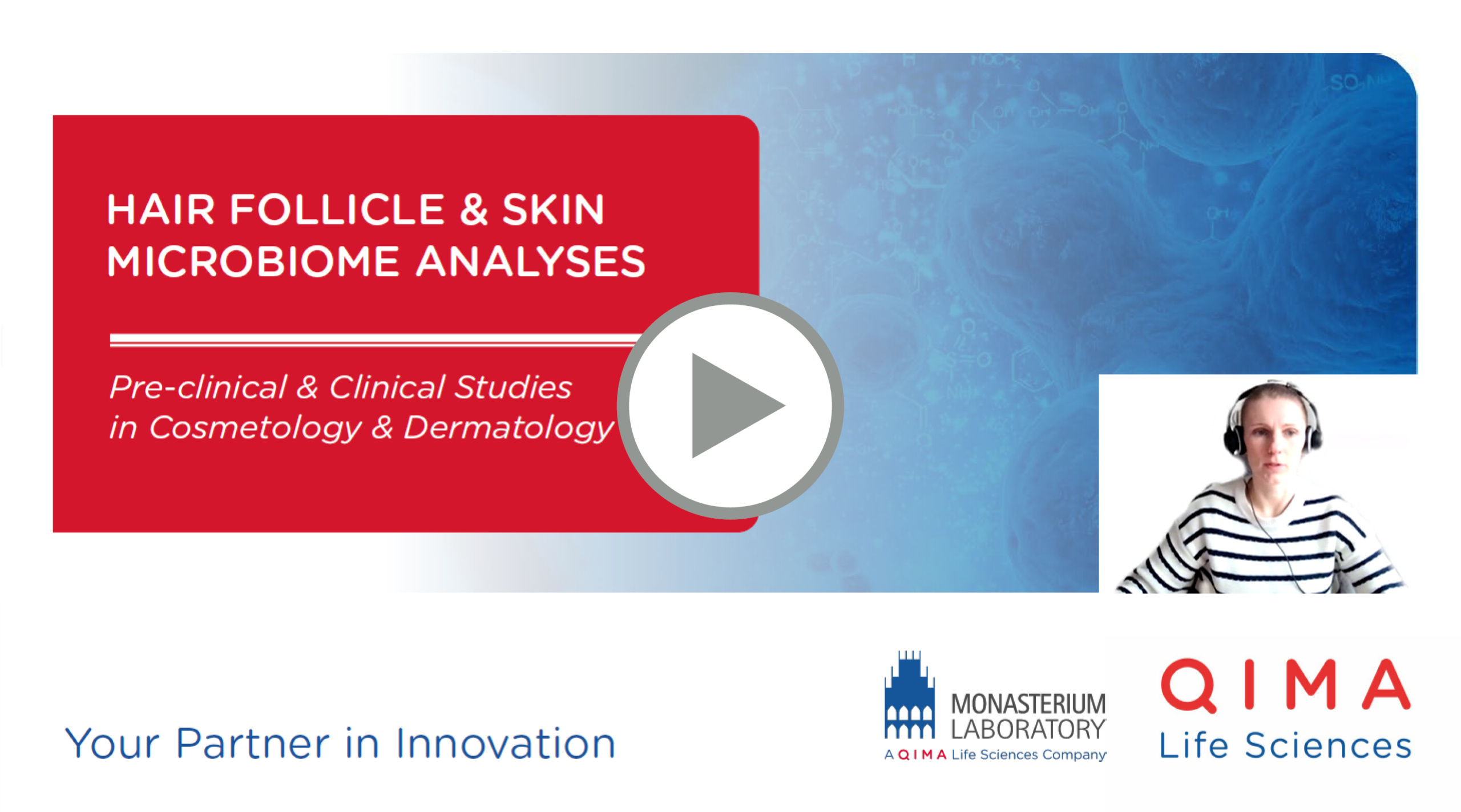When we discuss hair microbiota, we refer to the unique and complex system of microbial species living in hair follicles.
Hair follicles are embedded in deep skin invaginations, which creates a unique habitat for microorganisms.
Although the microbiota of skin and hair follicles share similar microorganism populations (i.e., different species of bacteria, fungi, viruses, and mites), they differ in population composition.
In hair follicles, microbiota mostly consists of Cutibacterium acnes and Malassezia restricta, and to a lesser extent Staphylococcus epidermidis and Streptococcus spp.
The hair microbiota plays a crucial role in maintaining scalp homeostasis, so any imbalance in its composition can lead to disorders (such as dry skin, oily skin, dandruff, etc.) or pathologies (including alopecia areata, acne, etc.).
* “Monasterium Laboratory” is now QIMA Monasterium, a member of QIMA Life Sciences.
Our Models & Assays To Address Hair Microbiota
Our models and assays can help substantiate your claims regarding the efficacy of various products, including ‘microbiota-friendly’ formulations, bacteriostats, antimicrobials, prebiotics, probiotics, anti-acne treatments, anti-dandruff solutions, and more.
MODELS
Thanks to our expertise in tissue engineering, QIMA Life Sciences have developed complex ex vivo models and associated assays to study and analyze hair follicle microbiota.
- Full-length or amputated human hair follicles
- Telogen microdissected hair follicles
- Co-culture human hair follicles with autologous skin-resident immune cells
- Human full thickness scalp skin
- Re-innervated scalp skin
With those models, we can investigate whether compounds, drugs or finished products can protect hair follicle microbiota from dysbiosis.
In addition, our models can also mimic pathological conditions, such as chemo-induced alopecia, to evaluate how bacterial substances can interfere with skin homeostasis.
Finally, we can perform comparative analyses using patient material from lesional and non-lesional scalp and compare it with the microbiome of healthy volunteers.
TECHNIQUES
Specifically, as standardized techniques, together with our collaborating partners, we offer:
- In situ hybridization to investigate 16S rRNA and certain bacterial strains in situ
- Bacterial 16S rRNA sequencing for bacterial community analysis
- ITS sequencing for fungal community analysis
- Shotgun sequencing for microbial community analysis
- Agar diffusion assay of selected bacterial and fungal strains
- Total germ count in hair follicles or culture medium
- Screening for bacteriocyte and virocyte activity
- Laser capture microdissection for analysis in selected hair follicle compartments
We also provide the option to manipulate the hair follicle microbiome using antibiotics and to analyze the expression of antimicrobial peptides.
Additional readout parameters are available, and customized experiments can be designed to meet the needs of our customers.
QIMA Life Sciences provides a wide range of microorganisms tested by our laboratory and available for in vitro testing:
BACTERIA

GRAM +
- Staphylococcus aureus
- Staphylococcus epidermidis
- Cutibacterium acnes
- Corynebacterium xerosis
- Streptococcus pyogenes
- Mix of several strains (upon request)
- Other strains upon request
GRAM –
- Pseudomonas aeruginosa
- Other strains upon request
VIRUSES

- Herpes simplex virus type 1 (HSV-1)
- Human Rhinovirus 16 (HRV-16)
YEAST

- Malassezia restricta
- Malassezia globosa
Clinical Evaluation of Hair Microbiota
SCALP MICROBIOTA ANALYSIS
Our company has developed ready-to-use non-invasive collection kits to analyze the lipids and biomarkers of the skin surface from your samples or from those of your clinical center.
The qualitative and quantitative analysis of the bacteria present on the surface of the skin are carried out on samples with our SW Kit (swabbing). They are performed using the following techniques:
- Traditional microbiology on agar
- Targeted qPCR
- Non-targeted metagenomic analysis
In addition, the analysis of sebaceous lipids (triglycerides and fatty acids) gives information on the lipase activities of bacteria and yeasts such as C. acnes and M. furfur, involved in the development of acne and dandruff respectively.
Watch our short video on
Hair Follicle Microbiome

Scientific Publications on Hair Microbiota
NEED MORE INFORMATION?
We are here to help!





